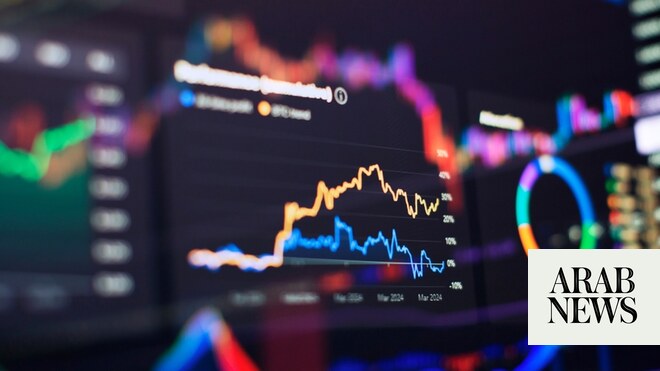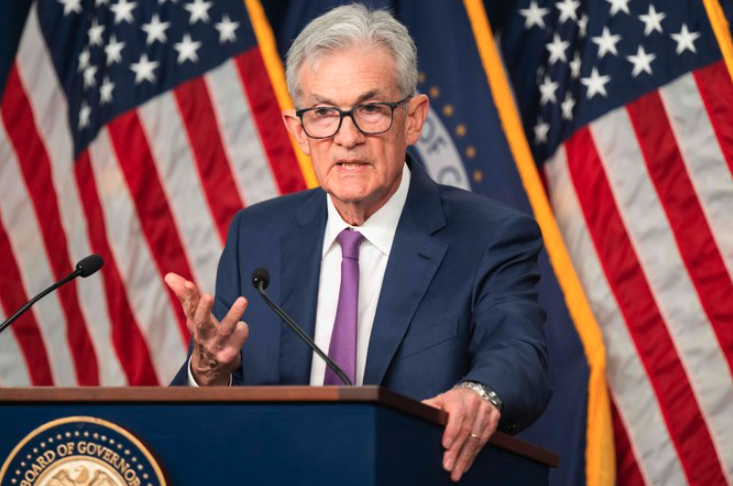Arab Markets See Growth In Select Exchanges Amid Overall Regional Declines In September: AMF

RIYADH: A smattering of Arab markets saw positive growth in September, despite an overall decline for the region, according to the latest monthly bulletin released by the Arab Monetary Fund.
The Damascus Stock Exchange led the way with a 55.36 percent increase in trading volume, while the Muscat Stock Exchange followed closely, recording a rise of 54.67 percent.
Abu Dhabi also demonstrated strong performance, with a 37.28 percent surge in trading value, reflecting investor optimism and sustained economic activity.
Although some exchanges faced challenges, the overall market resilience in the Arab region contrasts sharply with the struggles seen in Western markets, according to the AMF.
In its 51st edition of the report on Arab Financial Markets, the organization provided a comprehensive analysis of these trends, offering detailed insights into trading volumes and values across the region’s stock exchanges.
The report showed that Arab markets overall saw a 10.78 percent drop in trading volume and a 2.76 percent decline in trading value compared to the previous month.
Saudi Arabia’s financial market saw a 12.42 percent decline in trading volume, with Dubai and Egypt also experiencing decreases of 7.31 percent and 4.36 percent, respectively.
The report suggested that these fluctuations were influenced by a mix of regional market sentiment, sector-specific performance, and global economic concerns.
The AMF’s bulletin provided a thorough overview of the financial landscape across the 16 Arab markets, highlighting a complex interplay of growth, stability, and decline, driven by both regional dynamics and broader international pressures.
Performance of the AMF Composite Index
One of the key highlights of the report is the performance of the AMF’s composite index, which measures the overall activity of Arab financial markets.
For September, this indicator rose by 0.58 percent, settling at 496.70 points. This represents a slight improvement from August, indicating a mild but steady recovery across Arab exchanges.
This increase corresponds to a gain of 2.87 points by the end of August.
Notably, 10 of the 14 Arab stock markets included in the index contributed positively to the overall growth, reflecting a diverse but generally favorable movement in market performance.
However, four exchanges recorded declines, reflecting the challenges some markets faced amid ongoing economic adjustments.
Leading performers: Iraq and Damascus take the lead
In terms of individual market performance, the Iraq Stock Exchange emerged as the standout performer in September, with its index surging by 8.26 percent.
This significant growth was followed closely by the Damascus Stock Exchange, which posted a 6.57 percent increase.
These strong gains highlight a continued upward trajectory in certain segments of the Arab financial markets, driven by positive market sentiment and regional economic developments.
Other Arab bourses also showed positive momentum, though to a lesser degree. Dubai’s Financial Market climbed by 4.12 percent, and Qatar’s Exchange rose 4.03 percent, both marking solid gains.
These performances were supported by the continued growth of sectors such as real estate, finance, and consumer goods.
The Saudi financial market, although not as dynamic as some of its peers, still recorded a 0.67 percent rise, indicating stability as the exchange continues to adjust to broader regional and global changes.
Markets in decline: Palestine and Kuwait struggle

Kuwait Stock Exchange building in central Kuwait City. Shutterstock
While the report detailed significant gains in several markets, it also noted that not all Arab exchanges experienced growth.
The Palestine Exchange posted the largest decline, with its index dropping by 2.96 percent, followed by the Muscat and Kuwait markets, which fell by 0.76 percent and 0.62 percent, respectively.
These drops were influenced by specific internal market dynamics and reflect the challenges these markets faced during the month of September.
The decline in the Palestinian market can be partially attributed to political uncertainties and regional volatility that dampened investor confidence.
Similarly, economic adjustments and sectoral rebalancing weighed heavily on the Muscat and Kuwait markets, causing them to post negative returns for the month.
A global comparison: Arab markets vs. world indices
The report noted that the MSCI Emerging Markets Index for Asia posted a 7.80 percent rise, demonstrating resilience in the face of global economic challenges.
Latin American markets experienced a slight decline of 0.06 percent during the same period.
In contrast, European and American indices such as the FTSE and Nikkei saw declines of 1.67 percent and 1.88 percent, respectively.
This comparison highlights the relatively positive performance of Arab markets, particularly when viewed in the context of global financial trends.
This is particularly evident when considering that many Arab stock markets — particularly Iraq, Damascus, and Dubai — posted significant gains, even as global markets grappled with inflationary pressures and geopolitical instability.
Central bank policies: Interest rate cuts and market impacts

US Fed Chair Jerome Powell. File/AFP
One of the key developments during September was the decision by the US Federal Reserve to reduce its interest rate range to 4.75 percent - 5 percent, marking the first cut in four years.
This decision followed eight consecutive rate hikes and was driven by the Federal Reserve’s assessment of easing inflationary pressures and the need to boost liquidity in the economy.
In response to the Fed’s decision, several Arab central banks followed suit to maintain economic stability and investor confidence, and also because many currencies in the region are pegged to the US dollar.
Saudi Arabia’s central bank reduced its repo rate by 50 basis points, while Bahrain, the UAE, and Kuwait made similar cuts.
Oil and gold: Geopolitical influence and market reactions
Oil prices fell during September, with Brent crude and West Texas Intermediate seeing declines of 7.3 percent and 5.9 percent, respectively.
The report attributes this drop to growing concerns about increased oil supply in global markets, coupled with weaker demand, especially from China, a key player in imports of the commodity.
The AMF pointed to OPEC’s decision to extend its voluntary production cuts for two more months, aiming to stabilize the market amid these fluctuations.
Despite the short-term drop in prices, OPEC+ reaffirmed its commitment to gradually lifting these cuts after November, with the possibility of adjustments based on global market conditions.
Meanwhile, gold prices surged by 5.2 percent in September, as investors sought safe-haven assets amid ongoing global economic uncertainty. By the end of the month, the price of gold reached $2,637.60 per ounce, reflecting the continued demand for stable, risk-averse investments.
Market capitalization: A snapshot of growth and decline
On a regional level, total market capitalization increased by 0.53 percent compared to August.
Beirut’s stock exchange led the charge, with its market capitalization growing by 10.97 percent, followed by Damascus, which saw a 6.31 percent increase.
However, the Saudi financial market, despite its overall stability in terms of index performance, experienced a slight decline in market capitalization by 1.26 percent, reflecting ongoing adjustments in its economic and financial sectors.
Similarly, Palestine and Oman saw market capitalization decreases of 2.41 percent and 2.08 percent, respectively.
Saudi Arabia Poised To Become Mideasts Silicon Valley, Say Experts
RIYADH: Saudi Arabia is rapidly transforming into a regional technology hub, drawing comparisons to Silicon Valley, than... Read more
How Saudi Entrepreneurs Are Navigating The Shift To Public Markets
RIYADH: As startups approach the critical stage of an initial public offering, one of their biggest challenges is the tr... Read more
UK-Saudi Trade Ties Deepen As 50 British Firms Set Up Regional HQs In Kingdom
RIYADH: The strong investment growth in Saudi Arabia’s economy has led 50 British companies to set up regional headqua... Read more
IMF Warns Of Economic Slowdown, But Rules Out Global Recession
WASHINGTON: Rising trade tensions and sweeping shifts in the global trading system will trigger downward revisions of th... Read more
Libyans Grapple With Fresh Currency Devaluation
TRIPOLI: Already worn down by years of political turmoil and economic hardships, Libyans are now facing a sharp deterior... Read more
Closing Bell: Saudi Main Index Closes In Red At 11,502
RIYADH: Saudi Arabia’s Tadawul All Share Index dipped on Thursday, losing 81.44 points, or 0.7 percent, to close at 1... Read more

